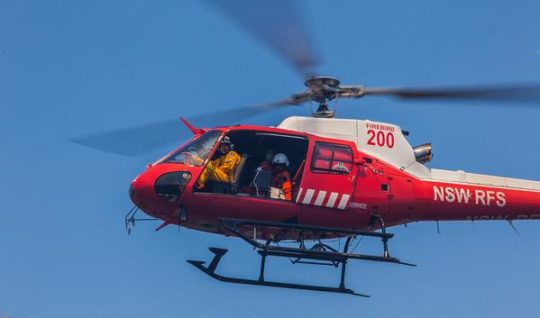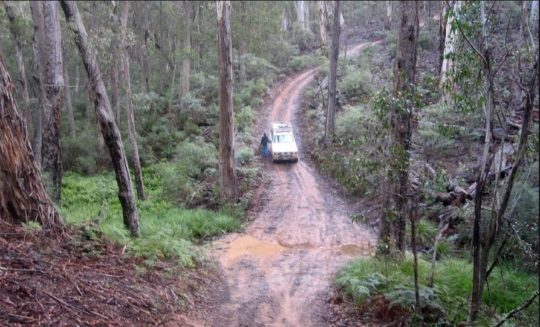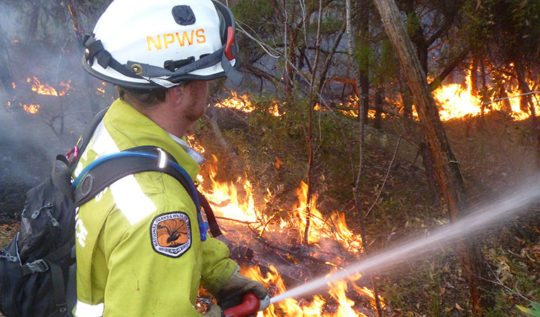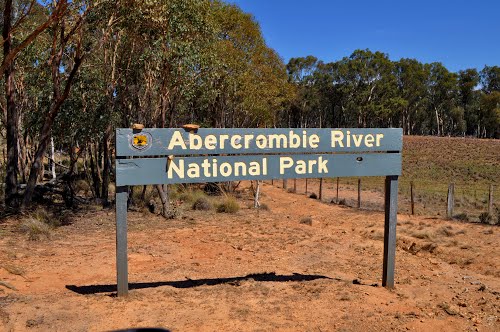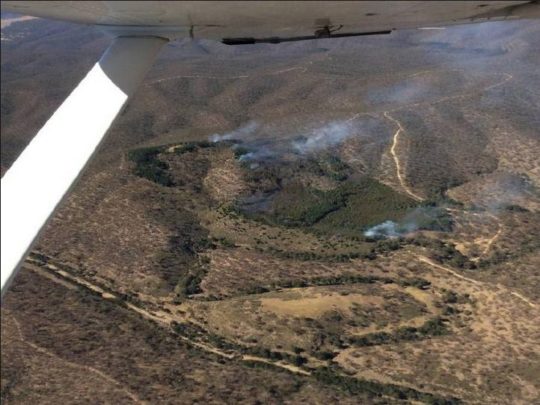Abercrombie River NP a government arson target
Saturday, May 13th, 2017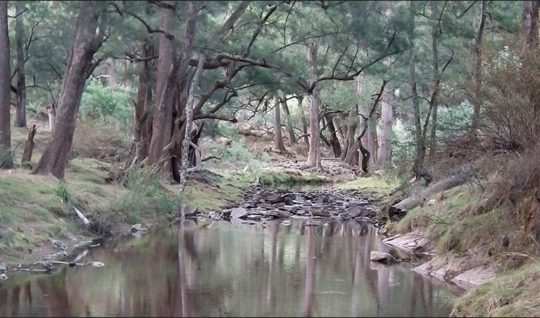 Looks natural, but decades of cattle have toxified the riparian zone’s soil and flora co-biology
Looks natural, but decades of cattle have toxified the riparian zone’s soil and flora co-biology
From 12th-14th May 2017, the New South Wales National Parks and Wildlife Service has planned to set fire to 9km2 of designated wildlife habitat in the Abercrombie River National Park south of the town of Oberon. It’s about 150km west of the Sydney GPO as the crow flies.
NPWS Area Manager Kim de Govrik has contracted a helicopter to indiscriminately drop incendiaries into the remote and steep wilderness valleys and ridgelines around Silent Creek, west of Abercrombie Road. It will blanket burn vast swathes of remnant forest within the national park.
“NPWS will use a helicopter and ground crews in the steep terrain in the south-east corner of the Park,” Mr de Govrik said.
Any wonder how Abercrombie’s Silent Creek got its name?
Two generations ago, American marine biologist and author, Rachel Carson in 1962 launched her seminal book ‘Silent Spring’ telling how all life—from fish to birds to apple blossoms to human children—had been “silenced” by the insidious effects of DDT on Cape Code, Massachusetts.
DDT stands for Dichlorodiphenyltrichloroethane, a hazardous agricultural synthetic pesticide developed in the 1940s that also contaminated food crops and ecology and caused human cancer and Alzheimer disease. Its use wasn’t banned until 2001.
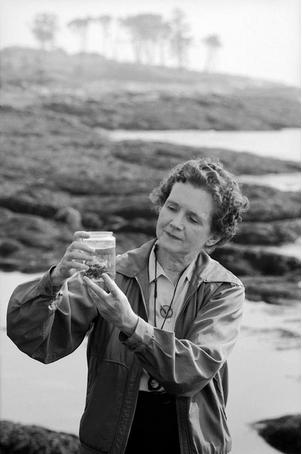 Rachel Carson at Cape Cod in 1958
Rachel Carson at Cape Cod in 1958
Source: ‘The Story of Silent Spring’, by the Natural Resources Defense Council, ^https://www.nrdc.org/stories/story-silent-spring
Hazard Reduction policy is finishing the extinction job across New South Wales and Australia. Originally termed ‘prescribed burning’, it too has been used since the 1940s originally by US foresters.
A camp stay in Abercrombie River National Park will disturb any informed conservationist of how silent the birdlife is in the region. No dawn chorus like in healthy forest habitats. And try camping at Silent Creek after the hazard reduction.
“People are advised that smoke from the burn may impact upon the local area and they should close their windows and bring their washing indoors. Those with asthma or people who are susceptible to respiratory problems should avoid the area or remain inside with windows and doors closed. Motorists are reminded to drive to the conditions, observe all warning signs and follow directions from fire crews,” Mr de Govrik said.
It is another contribution by government to hazardous and unnecessary smoke, toxic air pollution, greenhouse gases, and human global warming that governments complain about. Yet in contradiction, this burn is part of the NSW Government’s $76 million package of what it calls hazard reduction over six years.
Hazard Reduction Fallacy
To protect the scarce Australia’s remaining national parks, hazard reduction arson is run by state governments each in turn cut funding and otherwise set fire to the wildlife habitat, in case it burns. In New South Wales, the misnamed National Parks and Wildlife Service brings in its petrol-laden trucks and with the the firie-eyed enthusiasm of the Rural Fire Service sets fire to these ‘national parks’ every time the bush has grown back.
‘Hazard reduction’ is spin for habitat reduction. Habitat is deemed a hazard, and its forest a fuel risk. It is a policy of perpetuating inadequate fire fighting funding to responsibly and quickly detect, respond to and put out bushfires, like their urban professional counterparts are tasked to do. Instead, the cheap and ecologically destructive approach is to burn the habitagt in case it burns, so less to worry about. It is self-defeating. Like setting fire to ones home to stay warm in winter. Read up on the demise of the Rapa Nui on Easter Island.
The government’s hazard reduction Managing fire-prone NSW national parks requires a three-pronged approach, including fire planning, community education, and fuel management. When it comes to fuel like dead wood, NPWS conducts planned hazard reduction activities like mowing and controlled burning to assist in the protection of life, property and community.
So the $76 million claims “to boost bushfire preparedness and double hazard reduction in the State’s national parks“. Many such hazard reduction operations undertaken by NPWS across NSW each year, many with the assistance of the RFS, who relish the opportunity. Yet when bushfires occur, the same slow response ensues and the same widespread destruction often results, with or without hazard reduction. Ember attack in high winds travels kilometres beyond any hazard reduction ground.
But the government arson cult is entrenched. The lack of responsible funding is chronic.
No flora species has ever been made extinct because it has not been fire ravaged, yet how many species of fauna are on the edge of extinction because they continue to be?
Anyone with respiratory problems or suffering from Asthma is urged to visit NSW Health or the Asthma Foundation. Remnant native wildlife like the locally indigenous Black Pademelon, not so Common Wombat and Ringtail Possum, will just have to suck it up. Each of these species is territorial which means that they don’t relocate when fire devastates their home range.
What about the locally indigenous Echidnas, Eastern Grey Kangaroos, Emus, Platypus, Goannas, Eastern Water Dragons, Broad-headed Snakes, Wedge-Tail Eagles dependent the habitat and the more than sixty species of native birds?
.
Abercrombie a habitat island within a logged landscape
Abercrombie River National Park is situated surrounded by a logged landscape to the horizon. The Park was gazetted in 1995 as part of a nature conservation strategy supposedly aimed at maintaining the state of New South Wales’ biodiversity. It claims to protect an important part of remnant bushland within the south-
By incinerating it?
Actually, the truth is that the region has been too steep for pastoralists to trash, so it was left. Then the 19th Century gold prospectors got in and dig a lot of it up, before it was abandoned and surrounding farms let their pigs escape and go feral. Sadly, Abercrombie has become a play zone for weekend hoons.
When did the Parks Service last do a wildlife survey in Abercrombie? Back when the park was gazetted in 1995 when ecologist Christopher Togher wrote his Report on the Biodiversity and Land Management of the Abercrombie River Catchment.
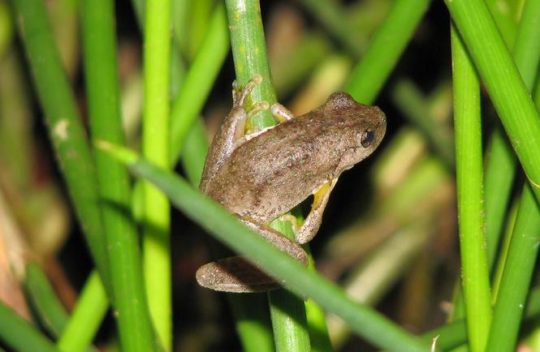 Booroolong Frog (Litoria booroolongensis). Locally indigenous to the Abercrombie River region, an endangered species
Booroolong Frog (Litoria booroolongensis). Locally indigenous to the Abercrombie River region, an endangered species
How many left in Silent Creek?
The ‘Parks Service’ thinks it knows best, and has atrophied to presume it exists to facilitate anthropocentric tourism and recreation. So the tourism arm of the ‘Parks Service’ has set the region aside for exploitation for four wheel touring, fishing, camping, canoeing and bushwalking with two toilets.
The National Parks Service website hypocritically states:
<<Abercrombie River National Park is a special place..This is an environment built for adventure. One of the most popular activities in the park is 4WD touring (and trail biking). Some of the trails running along gorges and ridges can be pretty challenging, even for the experienced driver. For those with plenty of energy, you can also explore these trails on mountain bikes..>>
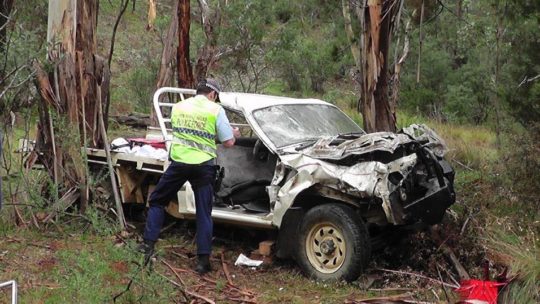 Near Bummaroo Ford Abercrombie River (hoon park), 19th May 2015
Near Bummaroo Ford Abercrombie River (hoon park), 19th May 2015
On the same page, Parks Services recognises that Abercrombie River National Park is a special place for nature and wildlife conservation. Then it recommends people “get out into the national park and have an adventure!” It’s all about the experience see.
Oberon Council, home of lumberjacks, claims it is:
<<surrounded by a number of national parks and is the perfect base to experience these enormous sanctuaries of pristine bushland and all they have to offer. Our national parks are a haven for adventure seekers, with bushwalking, mountain biking, canyoning, camping, abseiling, rock climbing, fishing, 4WD touring and so much more.>>
But you have to drive through vast areas of clear felled forest and plantations around Oberon to get there.
There are four camping sites within the Abercrombie River National Park at Bummaroo Ford, The Sink, The Beach and Silent Creek – all overused.
Feral pigs run riot throughout the region, happily destroying the riparian zones of the watercourses with impunity. Over the decades, cattle and now feral pigs have dug up the riparian vegetation causing bank erosion. They have toxified the soil biology causing weed infestation and facilitating the spread of flora diseases such as dieback – so destroying the region’s native ecosystem.
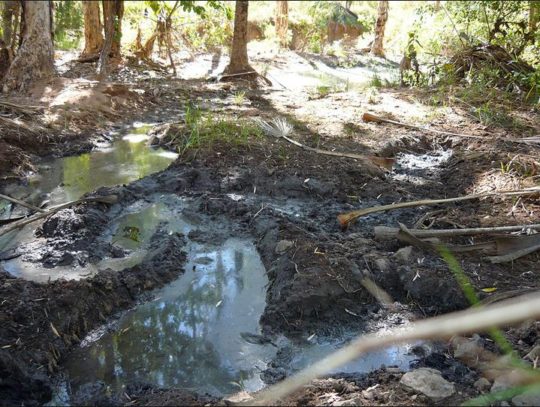 Feral pigs thrive in the Australia bush and cause immense environmental damage especially to watercourses.
Feral pigs thrive in the Australia bush and cause immense environmental damage especially to watercourses.
[Source: ‘Pig damage , Cycas brunnea habitat, by Alastair Freeman, 2010, ^https://wetlandinfo.ehp.qld.gov.au/wetlands/ecology/components/species/?sus-scrofa]
In the 1960s there were about 50,000 pig farmers across Australia, and many escaped. The Abercrombie River National Park has been left to become a haven for feral pigs. Yet the Plan of Management states: “Within the Abercrombie catchment is an extensive amount of remnant riparian vegetation which is extremely important in maintaining water quality and habitat for threatened aquatic ecosystems.” (Source: ‘Abergrombie River National Park Plan of Management 2006, 2.2.2. Significance of Abercrombie River National Park, page 2).
<<Feral pigs are opportunistic scavengers and prey on invertebrates, bird eggs, small mammals, reptiles, amphibians and soil invertebrates. Their selective feeding habits also affect the biodiversity of vegetation and creates competition for food resources of native species. Feral pigs have negative impacts on native ecological systems including changing species composition, disrupting species succession and by altering nutrient and water cycles. Impacts can be direct or indirect, acute or chronic, periodic or constant, and may be influenced by changing seasonal conditions. Feral pigs tend to congregate around water as they are highly susceptible to heat. The impact of the pigs wallowing in wetlands and watercourses totally destroys these finely balanced ecosystems. They also prey on ground dwelling mammals, reptiles and birds, in some cases putting extensive pressure on rare and endangered species.>>
Source: ^http://www.animalcontrol.com.au/pig.htm
Then there are the feral rabbits, feral goats, feral deer and feral recreational hoons. The absence of park rangers is conspicuous.
How Australia treats its national parks
The ‘Parks Service’ website promotes “rivers and creek systems within the park provide habitat for trout cod and Macquarie Perch, which are totally protected species. River blackfish, silver perch and the Murray cray are also found which are regionally rare. Introduced trout may only be caught during the trout season from the October long weekend to the June long weekend.“
So it encourages people to fish protected species?
In Sunday 7th January 2014 (hot mid-summer), campers abandoned their camp fire without extinguishing it. Their haphazard campsite, situated on Macks Flat near a pine plantation about 1km north of The Beach, was not approved It burned around 50 hectares including within the Abercrombie River National Park. It was not a designated camping site and the campers went unpunished.
The NSW National Parks and Wildlife Service is legally responsible under the NSW National Parks and Wildlife Act 1974 to to protect and conserve areas containing outstanding or representative ecosystems, natural or cultural features or landscapes or phenomena that provide opportunities for public appreciation and inspiration and sustainable visitor use.
<<Under the NSW National Parks and Wildlife Act national parks are managed to:
-
Conserve biodiversity, maintain ecosystem functions, protect geological and geomorphological features and natural phenomena and maintain natural landscapes;
-
Conserve places, objects, features and landscapes of cultural value;
-
Protect the ecological integrity of one or more ecosystems for present and future generations;
-
Promote public appreciation and understanding of the park’s natural and cultural values;
-
Provide for sustainable visitor use and enjoyment that is compatible with conservation of natural and cultural values;
-
Provide for sustainable use (including adaptive reuse) of any buildings or structures or modified natural areas having regard to conservation of natural and cultural values; and
-
Provide for appropriate research and monitoring.>>
This environmental law applies to Abercrombie River National Park.
Yet strategic under-funding, under-resourcing and under-staffing forces the service to neglect these core responsibilities. Hoons run riot and the park is abused. What a disgrace! The environmental law is weak because there are no standards, measures or breach penalties. It was drafted to be a motherhood statement to appease malleable conservationists.
Since being gazetted in 1995, Abercrombie River National Park has been treated as a recreation park, not as a wildlife sanctuary in any way, except on paper to pretend the government actual has a conservation bone in its body. It’s called ‘Greenwashing’. NPWS works very closely with the Upper Lachlan Tourist Association, and the Rural Fire Service.
In 2010, National Parks and Wildlife staff carried out a 520 hectare hazard reduction burn in the north of Abercrombie River National Park, with the RFS in tow. Kanangra Boyd area manager Kim de Govrik said at the time the burn off took place in the Felled Timber Creek area.
<<The park is now open and ready for the influx of eastern campers,” Mr de Govrik said. “The operation was a great success thanks to the assistance of the local RFS brigades. RFS volunteers from Jerrong/Paling Yards, Gurnang and Black Springs helped in putting in the 11km of fire edge.>>
During 2009, National Parks and Wildlife completed a record 230 burns, covering nearly 80,000 hectares of native habitat.
NPWS is targeting the state’s 225 national parks and reserves for programmatic habitat reduction under its current $76 million programme:
- Crowdy Bay National Park
- Sea Acres National Park
- Yuraygir National Park
- Mimosa Rocks National Park
- Jervis Bay National Park
- Nightcap National Park
- Hill End Historic Site
- Montague Island Nature Reserve
- Wombeyan Karst Conservation Reserve
- Worimi National Park
- Sturt National Park
- Dorrigo National Park
- Wyrrabalong National Park
- Yanga National Park
- Popran National Park
- Yellomundee Regional Park
- Blue Mountains National Park
- Dharawal National Park
- Blue Gum Hills Regional Park
- Warrumbungle National Park
- William Howe Regional Park
- Wollemi National Park
- Wolli Creek Regional Park
- Wollumbin National Park
- Nymboi-Binderay National Park
- Lane Cove National Park
- Ben Boyd National Park
- Tomaree National Park
- Coffs Coast Regional Park
- Murray Valley National Park
- Rouse Hill Regional Park
- Georges River National Park
- Cape Byron State Conservation Area
- Mutawintji National Park
- Glenrock State Conservation Area
- Royal National Park
- Myall Lakes National Park
- Oxley Wild Rivers National Park
- Eurobodalla National Park
- Gaagal Wanggaan (South Beach) National Park
- Brisbane Water National Park
- Morton National Park
- Gundabooka National Park
- Corramy Regional Park
- Mount Kaputar National Park
- Berowra Valley National Park
- Bongil Bongil National Park
- Kinchega National Park
- Dharug National Park
- Munmorah State Conservation Area
- Murramarang National Park
- Abercrombie Karst Conservation Reserve
- Abercrombie River National Park
- Muogamarra Nature Reserve
- Garigal National Park
- Mount Canobolas State Conservation Area
- Borenore Karst Conservation Reserve
- Bouddi National Park
- Kosciuszko National Park
- Ku-ring-gai Chase National Park
- Arakwal National Park
- Border Ranges National Park
- Pilliga National Park
- Mungo National Park
- Leacock Regional Park
- Paroo-Darling National Park
- Washpool National Park
- Hat Head National Park
- Cattai National Park
- New England National Park
- Heathcote National Park
- Budderoo National Park
- South East Forests National Park
- Bents Basin State Conservation Area
- Bundjalung National Park
- Barrington Tops National Park
- Jenolan Karst Conservation Reserve
- Arakoon National Park
- Sydney Harbour National Park
- Tyagarah Nature Reserve
- Cottan-Bimbang National Park
- Illawarra Escarpment State Conservation Area
- Boonoo Boonoo National Park
- Kattang Nature Reserve
- Yerranderie Regional Park
- Yuranighs Aboriginal Grave Historic Site
- Turon National Park
- Hunter Wetlands National Park
- Towra Point Nature Reserve
- Woomargama National Park
- Biamanga National Park
- Culgoa National Park
- Cudgen Nature Reserve
- Cullendulla Creek Nature Reserve
- Dooragan National Park
- Yarriabini National Park
- Coorabakh National Park
- Wallingat National Park
- Wallumatta Nature Reserve
- Mann River Nature Reserve
- Queens Lake Nature Reserve
- Yanununbeyan State Conservation Area
- Deua National Park
- Yengo National Park
- Kings Plains National Park
- Koreelah National Park
- Willandra National Park
- Willi Willi National Park
- Wingham Brush Nature Reserve
- Woko National Park
- Kwiambal National Park
- Lake Macquarie State Conservation Area
- Jilliby State Conservation Area
- Murramarang Aboriginal Area
- Wadbilliga National Park
- Wallarah National Park
- Terry Hie Hie Aboriginal Area
- Lake Innes Nature Reserve
- Cambewarra Range Nature Reserve
- Cecil Hoskins Nature Reserve
- Chaelundi National Park
- Kanangra-Boyd National Park
- Karuah National Park
- Parr State Conservation Area
- Dunggir National Park
- Brimbin Nature Reserve
- Brindabella National Park
- Murrumbidgee Valley National Park
- Cocoparra National Park
- Robertson Nature Reserve
- Livingstone National Park
- Gibraltar Range National Park
- Burragorang State Conservation Area
- Dalrymple-Hay Nature Reserve
- Deriah Aboriginal Area
- Capertee National Park
- Coramba Nature Reserve
- Goobang National Park
- Tapin Tops National Park
- Goolawah National Park
- Clyde River National Park
- Monga National Park
- Mount Imlay National Park
- Bindarri National Park
- Muttonbird Island Nature Reserve
- Seven Mile Beach National Park
- Tweed Heads Historic Site
- Palm Grove Nature Reserve
- Goulburn River National Park
- Nangar National Park
- Ulidarra National Park
- Toonumbar National Park
- Weddin Mountains National Park
- Werakata National Park
- Broadwater National Park
- Carrai National Park
- Cascade National Park
- Mummel Gulf National Park
- Munghorn Gap Nature Reserve
- Dthinna Dthinnawan National Park
- Bungonia National Park
- Tallaganda National Park
- Torrington State Conservation Area
- Guy Fawkes River National Park
- Nadgee Nature Reserve
- Bournda National Park
- The Rock Nature Reserve – Kengal Aboriginal Place
- Bomaderry Creek Regional Park
- Oolambeyan National Park
- Sherwood Nature Reserve
- Warrabah National Park
- Towarri National Park
- Richmond Range National Park
- Gardens of Stone National Park
- Macquarie Nature Reserve
- Scheyville National Park
- Mount Grenfell Historic Site
- Macquarie Pass National Park
- Victoria Park Nature Reserve
- Ngambaa Nature Reserve
- Jerrawangala National Park
- Nowendoc National Park
- Seaham Swamp Nature Reserve
- Brunswick Heads Nature Reserve
- Broken Head Nature Reserve
- Nattai National Park
- Bald Rock National Park
- Marramarra National Park
- Meroo National Park
- Moonee Beach Nature Reserve
- Mebbin National Park
- Budawang National Park
- Conimbla National Park
- Thirlmere Lakes National Park
- Copeland Tops State Conservation Area
- Boorganna Nature Reserve
- Werrikimbe National Park
- Whian Whian State Conservation Area
- Bangadilly National Park
- Bargo State Conservation Area
- Nymboida National Park
- Conjola National Park
- Coolah Tops National Park
- Mount Royal National Park
- Garawarra State Conservation Area
- Middle Brother National Park
- Limeburners Creek National Park
- Little Llangothlin Nature Reserve
- Barren Grounds Nature Reserve
- Booti Booti National Park
- Moore Park Nature Reserve
- Iluka Nature Reserve
- Watagans National Park
- Hartley Historic Site
- Mount Hyland Nature Reserve
- Cathedral Rock National Park
- Saltwater National Park
- Narrawallee Creek Nature Reserve
- Tooloom National Park
- Mother of Ducks Lagoon Nature Reserve
- Beni State Conservation Area
- Burning Mountain Nature Reserve
- Mullion Range State Conservation Area
- La Perouse area
- Kurnell area
.
Further Reading:
.
[1] Hazard Reduction Programme, NSW National Parks and Wildlife Service, ^http://www.nationalparks.nsw.gov.au/conservation-programs/hazard-reduction-program.
[2] ‘National Parks Experiences‘, by Oberon Council, ^http://www.oberonaustralia.com.au/visitor-information/national-parks/.
[3] Booroolong Frog (Litoria booroolongensis) , Australian Government Department of Environment and (contradictory) Energy, ^http://www.environment.gov.au/cgi-bin/sprat/public/publicspecies.pl?taxon_id=1844.
[4] Abercrombie River National Park, by NSW National Parks and Wildlife Service, ^http://www.nationalparks.nsw.gov.au/visit-a-park/parks/abercrombie-river-national-park/learn-more.
[5] Abercrombie River National Park, by Upper Lachlan Tourism, ^http://visitupperlachlan.com.au/abercrombierivernp.html.
[6] ‘The Story of Silent Spring – How a courageous woman took on the chemical industry and raised important questions about humankind’s impact on nature‘, by the Natural Resources Defense Council, ^https://www.nrdc.org/stories/story-silent-spring.
[7] ‘A Report on the Biodiversity and Land Management of the Abercrombie River Catchment‘, 1996, by Christopher Togher, National Parks Association of N.S.W., ^http://trove.nla.gov.au/work/16032156?selectedversion=NBD12849978.
